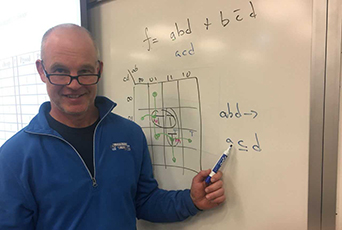“For a lot of students, lectures aren’t effective. I still do some in-class lectures, but I keep them short because it’s not typically a good use of classroom time.”
— Paul Ammann, associate professor of computer science

Computer science associate professor Paul Ammann, who has transformed his teaching style over the years, won a 2019 University Teaching Excellence Award from the Office of the Provost and the Stearns Center for Teaching and Learning. Photo by Nafisa Nur.
Figuring out the best way to teach a class is a lot like solving a complex puzzle, says computer science associate professor Paul Ammann.
It involves trial and error and discovering what works best, which has prompted Ammann to transform his teaching style. He’s still refining his techniques.
“I like puzzles. It would be a lot less interesting if I understood it all,” he says. “But there’s no danger of that happening. There’s always more to learn.”
That dedication to teaching earned him a 2019 University Teaching Excellence Award from the Office of the Provost and the Stearns Center for Teaching and Learning.
Ammann, who joined Mason Engineering’s faculty in 1989, once taught software engineering courses in the traditional way—delivering lectures with slides, working problems in front of the class, and giving students high-pressure midterms and finals.
But after he watched a video by Harvard educator Eric Mazur called Confessions of a Converted Lecturer, Ammann created an active-learning classroom in which students spend most of their time solving problems in groups, then discussing their answers.
“For a lot of students, lectures aren’t effective. I still do some in-class lectures, but I keep them short because it’s not typically a good use of classroom time.”
It wasn’t easy for him to move away from being the “sage on the stage who talks for two hours straight,” he says.
But letting students work in small groups and share their answers gives them a chance to make mistakes and learn in a safe environment. “Making mistakes is good for students. It’s important for students to get it wrong. They have to understand how you can get it wrong.”
He has altered his style in other ways. For instance, he learns the names of all the students in his classes at the beginning of the semester. Knowing names is important because people respond to it, he says.
If you’re an anonymous student in a class, you can slide by, he says. “If I know your name, you will work harder because I’ve given you recognition. The social response to that is to do something, and what I want students to do is study.”
Another change: He gives weekly quizzes instead of a midterm. "Students love this because they can bomb a quiz and still do fine in the class, but if they bomb a midterm, they’re in trouble. Quizzes also inspire them to study every week instead of twice a semester."
At the end of the course, he gives a final, but each student can bring in one page of handwritten notes, “which forces them to put the entire course in their head. This exercise gets them to think about the course in one coherent, holistic way.”
One payoff for his hard work is the appreciation he receives from students. Ammann's evaluations are “uniformly outstanding,” says Sanjeev Setia, chairman of the Computer Science Department. “His course material is excellent and up-to-date. It is clear he puts a lot of thought into his lectures, quizzes, and assignments.”
Cassandra Bailey, (BS Computer Science ’17) describes Ammann as “an exceptional professor who makes his classes immersive, fun, and highly productive.”
Ammann has learned a lot about teaching from his colleagues. “The more people around you who do a good job, the better your teaching is going to be overall,” he says.
“The group dynamic reinforces the positive things that are going on. There is a go-team mentality.”
